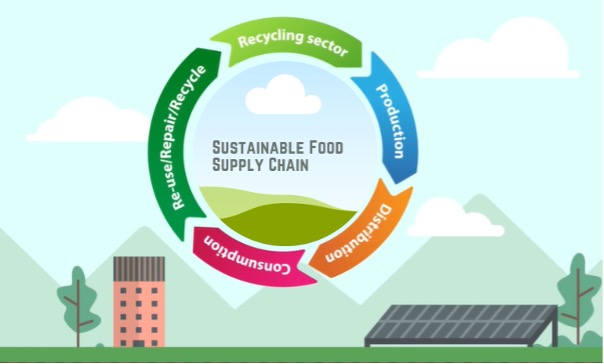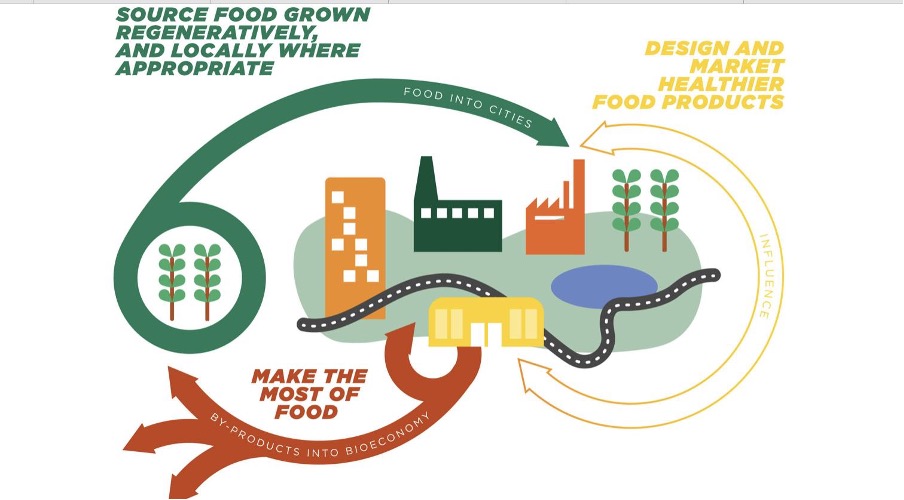
The significance of sustainability in supplies supply villenage is paramount, offering a multifaceted tideway to addressing environmental, economic, and social imperatives. Sustainable supplies production methods play a pivotal role in curbing the environmental impact of the industry by diminishing reliance on fossil fuels and incorporating renewable energy sources. Practices such as lard irrigation, rainwater harvesting, and conservation tillage optimise water usage and substantially reduce the overall environmental footprint of supplies production. Vastitude ecological benefits, embracing sustainability yields economic advantages by promoting waste reduction, streamlining logistics, and fostering innovative technologies, culminating in heightened efficiency and profitability for the unshortened supplies industry. Additionally, the resilience of the supplies system versus challenges which are posed by climate change, natural disasters, and disruptions is fortified through sustainable production practices.
Socially, sustainable supplies production practices uplift the well-being of farmers, farmworkers, and industry employees by ensuring pearly labour practices, unscratched working conditions and facilitating training and educational opportunities. These practices moreover contribute to polity development, fostering local supplies systems, generating job opportunities, and supporting the growth of small-scale farmers and businesses. In an era where consumers are increasingly mindful of the environmental and social repercussions of their supplies choices, meeting the demand for sustainable products not only burns trademark reputation but moreover cultivates consumer loyalty and enhances market share. In essence, the benefits of sustainable supplies supply villenage proffer vastitude ecological considerations, creating a harmonious equilibrium that encompasses economic viability and social responsibility.
At the heart of a sustainable supplies supply uniting is the adoption of environmentally friendly and socially responsible agricultural practices. Collaborative efforts between farmers, growers, and other stakeholders are essential. Initiatives such as joint programs, warranty schemes, and government-sponsored schemes pave the way for sustainable farming practices. For instance, India’s diverse agro-climatic zones require tailored climate-smart agricultural practices, including efficient irrigation, drought-resistant crops, and precision farming technologies.

Resource Depletion: The traditional supplies supply uniting is highly resource-intensive, relying on vast expanses of land, water, and energy to produce, process, and transport food. Agricultural practices often lead to soil degradation, water scarcity, and excessive energy consumption, contributing to environmental degradation.
Waste Generation: Supplies waste is a hair-trigger issue within the supply chain. From sublet to fork, a substantial portion of supplies is lost due to inefficient harvesting, storage, transportation, and consumer behaviour. This not only strains resources but moreover contributes to greenhouse gas emissions as the decomposing organic matter releases methane.
Supply Uniting Inefficiencies: The current supply uniting is often characterised by transportation, storage, and distribution inefficiencies. These inefficiencies not only increase financing but moreover result in higher emissions and energy consumption.
Climate Transpiration Impact: Climate transpiration poses a significant threat to the supplies supply chain. Events like lattermost weather events, shifting precipitation patterns, and rising temperatures can disrupt the cycle.
In the quest for a sustainable supplies supply uniting in India, several innovative initiatives and government-backed programs have emerged as powerful solutions. One such groundbreaking effort is the e-NAM (National Threshing Market), an online platform integrating agricultural markets nationwide. This platform facilitates transparent price discovery, enabling farmers to sell their produce to buyers directly. By eliminating intermediaries, e-NAM promotes a localised and transparent supplies supply chain, aligning with the Farm-to-Table movement. This movement not only connects consumers directly with nearby producers but moreover reduces the stat footprint associated with long-distance transportation, contributing to environmental sustainability.
National-level programs like the National Mission on Sustainable Threshing (NMSA) and the Rashtriya Krishi Vikas Yojana (RKVY) emphasise sustainable threshing practices, infrastructure development, value addition, and innovative agricultural methods. The Eat Right Initiative, launched by the Supplies Safety and Standards Authority of India (FSSAI), focuses on promoting healthy and unscratched eating habits through comprehensive public health campaigns.
To remoter revolutionize the threshing sector, the Indian government supports food-tech companies and agri-entrepreneurs, fostering a holistic tideway to sustainable development. The Digital Threshing Mission (DAM), initiated in 2021, leverages emerging technologies such as Artificial Intelligence, Machine Learning, Internet of Things, Blockchain, and deject computing. This initiative empowers agri-tech startups to write challenges in maintaining the quality and safety of perishable supplies throughout the supply chain.
Notable startups, including CropIn Technology Solutions, Ninjacart, and FlyBird Sublet Innovations, employ cutting-edge technologies like Big Data Analytics, AI, ML, Remote Sensing, and IoT to enhance agribusinesses, streamline supply chains, and modernize farmers’ livelihoods. Drone technology has moreover made significant contributions to agriculture, facilitating precise data collection, efficient resource utilization, and livestock monitoring.
In response to the rising sensation of healthy eating, velocious by the COVID-19 pandemic, India has seen a surge in successful entrepreneurs focusing on organic and locally sourced foods. The country boasts the highest number of organic farmers globally, and initiatives like Mission Organic Value Uniting Minutiae for North East Region (MOVCDNER) incentivize organic farming through financial aid and support.
India’s leadership in promoting millets, as part of the International Year of Millets initiative, emphasizes their higher nutrient content, tolerance to lattermost weather conditions, and contribution to supplies and nutrition security. To promote sustainable eating habits within traditional Indian cuisine, individuals are encouraged to make mindful choices such as consuming local and seasonal foods, supporting local markets, and exploring traditional preservation techniques to minimize wastage. These joint efforts contribute significantly to a healthy lifestyle and broader sustainability goals.

Taking a holistic approach, regenerative threshing stands as flipside steer of eco-friendly farming practices. Through strategies like yield rotation, imbricate cropping, and conservation tillage, regenerative threshing endeavors to enhance soil health, promote biodiversity, and curtail the environmental footprint of farming. The incorporation of compost and other natural inputs remoter bolsters its transferral to sustainable practices.
A cornerstone of sustainable sourcing and production lies in the concerted effort to minimize supplies waste at every stage of the supply chain, from sublet to table. Vastitude environmental benefits, this tideway seeks to efficiently utilize resources, reducing the strain on the supplies system.
Efficiency and transparency in supply uniting management sally as hair-trigger components in the megacosm of a sustainable supplies system. Streamlining the spritz of goods and services from production to consumption, while meantime reducing waste and enhancing transparency, paves the way for a increasingly eco-conscious tideway to supplies production.
A fundamental speciality of sustainable supply uniting management involves minimizing both waste and packaging. Recognizing the environmental and social impacts of excessive packaging and supplies waste, efforts are directed towards mitigating contributions to greenhouse gas emissions, preventing waterway pollution, and addressing issues of supplies insecurity.
Resource recovery and integrating the principles of the circular economy is vital for a sustainable supplies system. By prioritizing the longevity of materials and repurposing waste into valuable resources, a circular economy tideway minimizes waste and maximizes resource utilization.
To unzip these sustainability goals, various weightier practices come into play:
Public-Private Partnerships: Collaborative efforts between government agencies and private sector organizations play a pivotal role in addressing shared challenges and fostering sustainability in the supplies system.
Cross-Sectoral Partnerships: Collaboration among diverse stakeholders, including NGOs, wonk institutions, and businesses, helps harness the strengths of variegated sectors, fostering innovative solutions to sustainability challenges.
Supplier Partnerships: Collaboration between supplies companies and their suppliers is instrumental in promoting sustainable sourcing and production practices. This may involve implementing eco-friendly farming methods or reducing the use of harmful chemicals.
Certification schemes and labeling play a crucial role in enhancing transparency and guiding consumer choices:
Organic Certification: A seal of clearance confirming crops were grown without synthetic pesticides or fertilizers, and animals were raised without antibiotics or hormones.
Fairtrade Certification: Ensuring products are produced and traded under pearly labor conditions, with farmers receiving a just price for their efforts.
Carbon Footprint Labeling: Providing consumers with information well-nigh the greenhouse gas emissions associated with a product’s production, transportation, and packaging.
Animal Welfare Labeling: Offering insights into the unprepossessing welfare practices employed in a product’s production.

Ensuring traceability and transparency within the supply uniting is paramount. Traceability involves the worthiness to track supplies products from production to consumption, while transparency encompasses providing information well-nigh the origin, quality, and safety of products. By embracing these practices, we can collectively work towards a increasingly sustainable and upstanding future in supplies supply chains.
an minimize post-harvest losses and waste1.
India’s wits underscores the need for regulatory, support, tax, and newsy mechanisms to encourage the minutiae of socially, environmentally, and financially sustainable supplies supply systems1. National and international support for sustainable production systems and trade can remoter hoist the impact1.
The role of research and minutiae in fortifying sustainability cannot be overstated. Deeper understandings of sustainability issues linked to farming and food, coupled with the minutiae of technologies for tracking, tracing, waste management, and eco-efficiency, form the thrump-cap of progress1.
In India, where challenges like climate transpiration and logistical constraints persist, a robust research and minutiae ecosystem is vital. Collaboration between scientists, farmers, policymakers, and industry stakeholders can lead to innovative solutions that write the unique challenges faced by the country.
In weaving the narrative of sustainability from sublet to fork, collaboration emerges as the linchpin. Multi-stakeholder initiatives, informed by global weightier practices and tailored to local nuances, can hoist the baseline for supplies supply chains, ensuring resilience, efficiency, and sustainability.
India, with its diverse challenges, has the potential to sally as a steer of sustainable practices. By leveraging climate-smart agriculture, investing in infrastructure, embracing technology, ensuring supplies safety, and promoting local sourcing and sustainable farming, the nation can shape a resilient and sustainable supplies supply uniting As consumers, businesses, governments, and researchers come together, a future where safe, nutritious, and sustainable supplies is wieldy to all becomes an performable reality.
Written by – Sahana Valsang
Edited by – Mrunmayee Patwardhan
